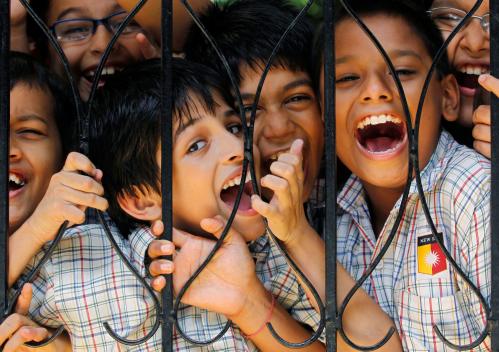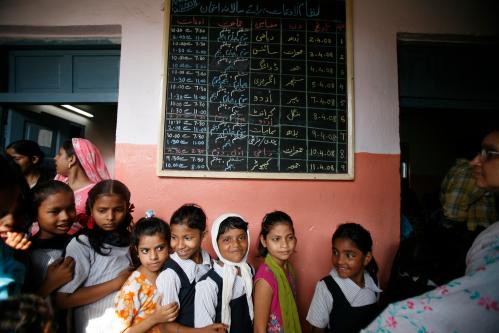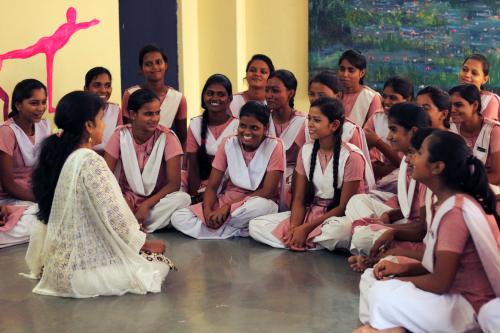In India, 320 million students have been affected by COVID-19 school closures, and though the government quickly recommended shifting to “online teaching,” this ignores India’s immense digital divide—with embedded gender and class divides. The 2017-18 National Sample Survey reported only 23.8 percent of Indian households had internet access. In rural households (66 percent of the population), only 14.9 percent had access, and in urban households only 42 percent had access. And males are the primary users: 16 percent of women had access to mobile internet, compared to 36 percent of men. Young people’s access is even less: A recent news report stated only 12.5 percent of students had access to smartphones. Furthermore, most teachers are ill-equipped for online teaching.
Study Hall Educational Foundation’s Response
This crisis has been a test of the Study Hall Educational Foundation’s (SHEF) skills, agility, and resilience. But because we’ve always taken a holistic approach to education, SHEF—the educational institution where I am founding president and CEO—was well-prepared to respond quickly and adaptively to the inequitable impacts of the coronavirus crisis on the vulnerable and disadvantaged.
A holistic response to whole lives
Teachers at SHEF have always looked at their students as “whole persons” and invited them to bring their whole lives into the classroom, with all the challenges. When the country first went into lockdown, teachers connected with their students by every means possible. This was a challenging task for three-quarters of our teachers whose students were on the wrong side of the digital divide, though teachers were able to connect with about half of their students’ families via mobile phones. Teachers galvanized other teachers and students, alumni, and parents to help track down their remaining students, eventually managing to connect with nearly 70 percent of our student body.
If it takes a village to raise a child, we must empower the village to teach the child.
After making contact, teachers then focused on fear management by spreading accurate information about the crisis, dispelling myths, urging caution, and diffusing panic. Then they found out what the students and families needed. Many students’ families had lost livelihoods, had no savings, and needed food. Teachers created an e-flyer with government relief measures, helplines, and locations, and personally helped provide rations and cooked food for those families without documents to access relief services.
Using digital volunteers to teach in a limited environment
Once these basic needs were taken care of, teachers then used whatever digital means were available to teach their students. Teachers galvanized an army of digital volunteers in the communities tasked with sharing the information on their devices to students without access to technology. To reach those low-tech students, teachers used voice messages, text messages, and phone calls. For high-tech students (i.e. with smartphones), teachers sent longer videos and used WhatsApp groups for discussions. To reach girls, most of whom had no access to phones, teachers even called fathers to ask how they were doing and to enlist their support for their daughters’ education. So far, the majority of fathers have responded positively, demonstrating how this crisis might be a great opportunity to develop positive relationships with fathers that improve their daughters’ education and well-being.
Lessons learned
While lamentable, the disruption to education systems worldwide offers valuable lessons and provides a unique opportunity to reimagine education, the curriculum, and pedagogy.
1. Address the digital divide. Technology has the potential to achieve universal quality education and improve learning outcomes. But in order to unleash its potential, the digital divide (and its embedded gender divide) must be addressed. Digital capabilities, the required infrastructure, and connectivity must reach the remotest and poorest communities. Access to technology and the internet is an urgent requirement in the information age. It should no longer be a luxury.
2. Reorient the curriculum. While teachers are struggling to learn digital ways of communicating with their students, it is clear that we need to pay close attention to what we teach. Our endeavor to educate children has been guided by the question “Who am I and what is my relationship with the universe and others in it?” This question has taken on even greater relevance during the crisis while decontextualized academic learning and a disproportionate focus on facts and information have been downgraded. This crisis is teaching us that curricula must be grounded in students’ realities, cultivating critical, creative, and flexible thinking, resilience, and empathy in students. Developing a symbiotic relationship with our environment has taken on a new urgency, and teachers must help students think about their relationship with the universe and everyone and everything in it.
SHEF has demonstrated how the development of social and political consciousness by students should be a major goal of education, and that lessons of equality and core democratic values should be given as much, if not more, importance in the official curricula than math, science, and language lessons. Now is the time for governments to integrate such a curriculum into the national curricular framework.
3. Empower a wider cadre of teachers. This crisis is forcing teachers to reinvent their roles from that of transferring information to enabling learning. The shift to distance learning has afforded many opportunities to teach differently, encouraging self-learning, providing opportunities to learn from diverse resources, and allowing customized learning for diverse needs through high-tech and low-tech sources.
But continuing education amid school closures has also taught us an important lesson about the role of the community in teaching our children. If it takes a village to raise a child, we must empower the village to teach the child. Improving the education system requires a decentralized, democratic community-based approach, where community ownership of education is cultivated. Important for this is the hiring of local teachers (with adequate Dalit and female representation), which increases teachers’ accountability to children’s families and their ability to empathize with students’ lives.
If COVID-19 school closures and their related challenges with distance learning have taught us anything, it is that we must liberate learning from outdated curricula and the disproportionate emphasis on information transfer.






Commentary
COVID-19 in India: Education disrupted and lessons learned
May 14, 2020